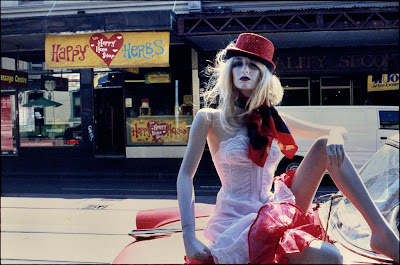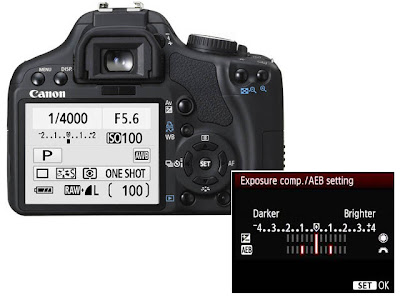The digital camera with its onboard computer and metering systems analyzing a complex array of information via various algorithms will come up with a standard exposure value for any given scene that you wish to photograph. This standard exposure value indicated by the camera’s meter will be aligned with Exposure Value (EV) “0”. And adhering to the zone system (of which we will discuss in detail in a later article) the predominant tones in the image will be rendered as the middle tonal value or middle grey (half way between black and white). But there are times when the standard exposure value set by the camera meter at EV “0” may not be right for the scene and hence the need for Exposure compensation. Exposure Compensation and Exposure Value
 |
| Photo By Mugley |
Exposure compensation has an inverse relationship with Exposure Value and so increasing or decreasing Exposure compensation by 1 stop will result in the increase or decrease of 1 stop in Exposure value (EV) in the opposite direction.So +1 Exposure compensation = -1EV and -1Exposure compensation = +1EV
 |
| Exposure Compensation |
What is Exposure Compensation?
Exposure compensation is a feature incorporated into digital cameras that allows the photographer to make adjustments to the exposure values (Aperture and Shutter Speed) indicated by the cameras meter.
 |
| Photo By Timothy K Hamilton |
When to Use Exposure Compensation?
Exposure compensation is mainly used in situations where the prevailing lighting conditions or the nature of the subject or scene will trick the camera into a less than optimal standard exposure reading.
 |
| Photo By Khairilfz |
Common Situations which needs Exposure Compensation
- While photographing a scene which has predominantly white or light toned areas such as snow, a white wall, or people wearing white dress the camera will essentially see a lot of reflected light and will expose for the bright areas resulting in an overall underexposed picture. Such situations may require a positive exposure compensation of +1EV to +2EV
- Opposite to the previous point when you are photographing a scene which has predominantly dark subjects or areas, the camera will see a lot of dark areas and will try to expose for them resulting in an overexposed image. Such situations may require a negative exposure compensation of -1EV to -2EV.
- When photographing backlit, side lit or top lit subjects, the cameras meter will see a lot of light hitting its sensor and will try to expose for it resulting in an over exposed image. Such situations may require a negative exposure compensation of -1EV to -2EV.
- When photographing subjects that are dimly lit than their backgrounds (background brighter than subject) e.g. photographing a person standing in the shade of a tree with open space in the background. Or an indoor situation with window in the background of the subject. In such situations the camera will try to expose for the bright light falling on it and will render the subject as a silhouette. These situations may require a positive exposure compensation of +1EV to +2EV
- When photographing in low light situations in which there are light sources included, such as street lights, neon lights etc or when shooting during sunrise or sunset the camera will have a tendency to underexpose and so would require an exposure compensation of +1EV to +2EV.
- Some camera models meters has a tendency to always underexpose or overexpose shots by a certain value in such cases exposure compensation may be permanently applied to get correct exposures.
Affect of Exposure Compensation in Various Camera Modes
 |
| Photo By Gfpeck |
Program Mode (P)
When shooting in program mode the camera will adjust both Aperture and Shutter Speed to get the desired result.
For example
The camera’s standard exposure reading is Aperture f/8 at Shutter Speed 1/125 at ISO 100 which is equivalent to EV 13. Reviewing the image in the LCD it appears to be underexposed and you apply an exposure compensation of +2EV, the resultant exposure values will be Aperture f/5.6 at Shutter Speed 1/60 at ISO 100 which is equivalent to EV11; a two point decrease.
Aperture Priority Mode (AV)
When shooting in Aperture Priority mode (AV) the camera will retain the aperture value set by the photographer and adjust the shutter speed to get the exposure right.
For example
Standard exposure value = f/8 at 1/125 at ISO 100 +1 EV = f/8 at 1/60 at ISO 100 and -1EV is f/8 at 1/250 at ISO 100
Shutter Priority Mode (TV)
When shooting in Shutter Priority mode (TV) the camera will retain the shutter speed value set by the photographer and adjust the aperture to get the exposure right.
For example
Standard exposure value = f/8 at 1/125 at ISO 100 +1EV = f/5.6 at 1/125 at ISO 100 and -1EV = f/11 at 1/125 at ISO 100
How to set Exposure Compensation
As different camera model and makes have different dials and switches it is best to refer your cameras instruction manual to learn how to set exposure compensation.
 |
| Photo By Craig |
In the next article we will discuss about Photography - Tips For Beginners - Depth of Field